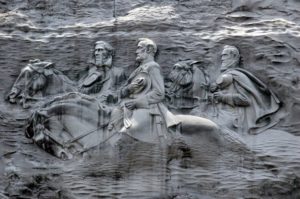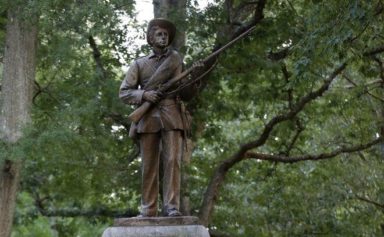
The United Daughters of the Confederacy was responsible for the creation of the Stone Mountain Confederate Monument, known as the South’s version of Mount Rushmore (Photo: Public Domain Pictures)
More than 150 years since the end of the Civil War, the United States has been unable to come to terms with a war that claimed 750,000 lives and was fought over the cause of white supremacy and the right of white men to continue to own Black people as chattel. Today, many white Americans have a positive attitude toward the slaveholding South, the Confederate cause and its symbolism.
This mindset was on display this week when White House Chief of Staff John Kelly claimed a “lack of ability to compromise led to the Civil War” and called the removal of Confederate monuments a “dangerous” scrubbing of history. Speaking with Fox News’ Laura Ingraham on her new show, “The Ingraham Angle,” Kelly also called Confederate General Robert E. Lee — who abused his slaves and became a soldier for white supremacy — “an honorable man” who “gave up his country to fight for his state.” Further, Kelly defended the Confederate monuments, arguing it is “dangerous” to scrub them away.
Kelly’s remarks come as GenForward released a poll on millennial racial attitudes. Among its findings, the poll found that while majorities of Black (83 percent), Latinx (65 percent) and Asian-American (71 percent) millennials believe the Confederate flag is a symbol of racism, a majority of whites ages 18 to 34 (55 percent) believe the flag is a symbol of Southern pride, and 62 percent oppose removing Confederate statues and symbols.
Other surveys have shown majorities believing the war was fought over a vague notion of states’ rights, with substantial minorities attributing the war to taxes or tariffs as opposed to slavery, the true answer. Over the years, Confederate sympathizers have distorted and rewritten the history of the Civil War to make the Confederates appear heroic and their cause glorious and noble. This project has been years in the making, through the efforts of groups such as United Daughters of the Confederacy (UDC), which lobbied for the construction of Confederate monuments and the banning of textbooks that were hostile to the role of the Southern secessionists in the Civil War.
Examining the original documents of the Southern states who seceded from the Union, it is clear that slavery was their motivation, and white supremacy their foundation. For example, the Constitution of the Confederate States, which mentions the word slave or its variations ten times, stated:
In all such territory the institution of negro slavery, as it now exists in the Confederate States, shall be recognized and protected be Congress and by the Territorial government; and the inhabitants of the several Confederate States and Territories shall have the right to take to such Territory any slaves lawfully held by them in any of the States or Territories of the Confederate States.
Immediately before secession, Georgia Governor Joseph E. Brown said:
Among us the poor white laborer is respected as an equal. His family is treated with kindness, consideration and respect. He does not belong to the menial class. The negro is in no sense of the term his equal. He feels and knows this. He belongs to the only true aristocracy, the race of white men.
The Declaration of Causes of Seceding States identified slavery as the primary motivation. The state of Georgia declared:
For the last ten years we have had numerous and serious causes of complaint against our non-slave-holding confederate States with reference to the subject of African slavery. They have endeavored to weaken our security, to disturb our domestic peace and tranquility, and persistently refused to comply with their express constitutional obligations to us in reference to that property, and by the use of their power in the Federal Government have striven to deprive us of an equal enjoyment of the common Territories of the Republic.
In its declaration, the state of Mississippi stated:
Our position is thoroughly identified with the institution of slavery — the greatest material interest of the world. Its labor supplies the product which constitutes by far the largest and most important portions of commerce of the earth. These products are peculiar to the climate verging on the tropical regions, and by an imperious law of nature, none but the black race can bear exposure to the tropical sun. These products have become necessities of the world, and a blow at slavery is a blow at commerce and civilization.
Texas spoke of “maintaining and protecting the institution known as negro slavery — the servitude of the African to the white race within her limits — a relation that had existed from the first settlement of her wilderness by the white race, and which her people intended should exist in all future time.”
UDC and other neo-Confederate organizations subscribe to the Cult of the Lost Cause, a concept promoted by white Southerners in the late 19th century that rebranded the Confederacy as “noble and praiseworthy,” denied that slavery was a central cause of the Civil War and toned down the brutality of slavery itself, even depicting the enslaved as happy. According to the Southern Poverty Law Center, this was a “whitewashing of history” to salvage white Southerners’ honor from defeat, and dominated Southern cultural history in the early 20th century. The cult of the Lost Cause was the core ideology of the Ku Klux Klan and the idea that Black emancipation was a threat to democracy and white women. The ideology has had an impact on Republican Party politics, as well as white nationalists and radical extremists.
In 1894, the United Daughters of the Confederacy was founded in Tennessee and became the foremost Southern women’s organization. UDC now has chapters in 33 states and the District of Columbia, and was responsible for erecting most of the Confederate monuments throughout the South. As of 2016, these 718 monuments included 551 built before 1950, 45 erected during the Civil Rights movement, and 32 built since 2000. For example, UDC was responsible for the Confederate Monument at Arlington National Cemetery, and Stone Mountain, Georgia, the South’s own Mount Rushmore, whose work was supervised by Ku Klux Klan members.
UDC instilled Confederate values in white youth to uphold white supremacy and states’ rights, lobbied state legislatures to provide military pensions to Confederate veterans, and helped form state-run homes for Confederate soldiers and widows. As Vox reported, UDC formed textbook committees and made school boards ban books that were “unjust to the South” and negatively portrayed the Confederacy. In addition, its auxiliary group, Children of the Confederacy, purportedly engages young people in “Southern” history. Open to descendants of men and women who served the Confederacy, according to its website, the group states its purposes include “to honor and perpetuate the memory and deeds of high principles of the men and women of the Confederacy,” “observe properly all Confederate Memorial Days,” and “serve society through civic affairs and to perpetuate National patriotism as our ancestors once defended their beliefs.”
UDC is open only to women related to Confederate veterans of the “War Between the States.” The Southern Poverty Law Center noted that UDC has affiliated with white supremacists and racist groups such as the Council of Conservative Citizens and the League of the South, while its publications have minimized the middle passage and argued that slave ship crews suffered the most.
“The UDC helped rewrite both the history of the Civil War and the history of Reconstruction. For the neo-Confederate groups the Civil War and Reconstruction was one long struggle in two phases,” Edward H. Sebesta — editor of “The Confederate and Neo-Confederate Reader,” “Neo-Confederacy: A Critical Introduction,” and author of “Pernicious: The Neo-Confederate Campaign against Social Justice in America” — told Atlanta Black Star. “The problem is that when discussing the United Confederate Veterans, the Sons of Confederate Veterans and the United Daughters of the Confederacy, people don’t realize the extent that neo-Confederates had in rewriting Reconstruction. Yes, there was the Dunning School at Columbia University (a group of scholars that objected to the role of the federal government in Reconstruction), but the UDC provided a major component to push the Dunning interpretation to the general public,” Sebesta added.
UDC policed textbooks and made it clear to textbook publishers that if they did not change their Civil War content, they would not have a market in the South, Sebesta noted. However, the influence of the group regarding textbooks waned by the time of the Civil Rights movement. “By the 1950s, a general [desire] by the public to support white supremacy favored a Lost Cause account of the Civil War and Reconstruction, and it becomes self-sustaining because it teaches or supports a cluster of white attitudes and beliefs in individuals who then insist that for the next generation the same be taught to them,” he said.
“We teach children white nationalism, in our textbooks and it should not be surprising that white nationalism is manifested in our society.”


